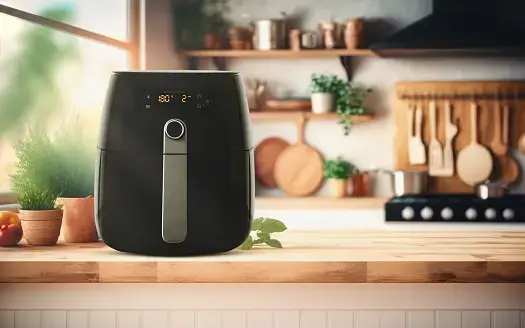In today’s fast-paced world, convenience is king. And when it comes to kitchen appliances, the air fryer is the hottest contender to dethrone the trusty microwave. With its promise of healthier cooking and crispy results, it’s no wonder this gadget has taken the culinary world by storm. But can it truly replace the microwave as our go-to appliance?
The rise of the air fryer has been nothing short of meteoric. With its ability to fry, bake, roast, and grill using minimal oil, it has captured the hearts (and stomachs) of food enthusiasts everywhere. But does it deliver on its promise of quick, easy, and tasty meals? And can it really compete with the convenience of the microwave?
In this article, we’ll delve into the pros and cons of the air fryer, weighing it against its longtime rival, the microwave. We’ll explore its cooking capabilities, health benefits, and overall performance. So, whether you’re a fan of crispy fries or a microwave popcorn lover, join us as we uncover the truth behind the rise of the air fryer and its potential to replace your trusty microwave.
How does an air fryer work?

Air fryers work by circulating hot air around the food to cook it. They use a heating element and a fan to create the hot air, which is then circulated inside the appliance. The hot air rapidly cooks the food, giving it a crispy texture similar to deep-fried food. Unlike deep frying, however, air fryers require little to no oil, making them a healthier alternative.
The heating element in an air fryer reaches high temperatures, typically ranging from 300 to 400 degrees Fahrenheit. The fan inside the appliance helps distribute the hot air evenly, ensuring that the food is cooked thoroughly. The cooking chamber of an air fryer is typically small and enclosed, allowing the hot air to circulate efficiently and cook the food quickly.
Air fryers also come with a variety of cooking settings, such as temperature control and timer functions, making it easy to adjust the cooking process according to the recipe’s requirements. Some air fryers even have pre-programmed settings for specific foods, taking the guesswork out of cooking.
Benefits of using an air fryer
There are several benefits to using an air fryer, which have contributed to its growing popularity. Firstly, air fryers offer a healthier cooking option compared to traditional deep frying. By using minimal oil or even no oil at all, air fryers can significantly reduce the amount of fat and calories in fried foods. This makes them a great choice for those who want to enjoy their favorite crispy dishes without the guilt.
Secondly, air fryers are incredibly versatile. They can be used to fry, bake, roast, and grill a wide range of foods, including vegetables, meats, and even desserts. This versatility makes air fryers a valuable addition to any kitchen, as they can replace multiple appliances and save both counter space and money.
Another benefit of using an air fryer is its speed. Air fryers cook food faster than traditional ovens, and in many cases, even faster than microwaves. This makes them a convenient option for those who are short on time but still want to enjoy delicious homemade meals. Additionally, air fryers produce crispy results comparable to deep frying, giving you that satisfying crunch without the need for excessive oil.
Air fryer vs. microwave: a comparison
When comparing the air fryer to the microwave, there are several factors to consider. One of the main differences is the cooking method. Microwaves use electromagnetic waves to heat food, while air fryers use hot air circulation. This difference in cooking method leads to different results in terms of texture and taste.
Microwaves are known for their ability to quickly heat food, making them ideal for reheating leftovers or cooking pre-packaged meals. However, microwaves can sometimes result in soggy or unevenly heated food, especially when it comes to items like pizza or french fries. On the other hand, air fryers excel at producing crispy and evenly cooked food, thanks to the circulation of hot air.
In terms of versatility, air fryers have an edge over microwaves. While microwaves are primarily used for heating and defrosting, air fryers can handle a wider range of cooking tasks. From frying chicken wings to baking cookies, air fryers offer a variety of cooking options that microwaves simply cannot replicate.
When it comes to health benefits, air fryers once again have the upper hand. As mentioned earlier, air fryers require minimal to no oil, resulting in lower fat and calorie content in cooked foods. Microwaves, on the other hand, do not impact the nutritional value of food significantly but can sometimes produce undesirable textures.
In terms of convenience, microwaves have long been the go-to appliance for quick meals. However, air fryers have made significant strides in providing speedy cooking times. While microwaves still hold an advantage in terms of heating pre-cooked food, air fryers can cook raw ingredients faster and produce better results in terms of taste and texture.
Cooking with an air fryer: popular recipes and techniques
One of the reasons behind the air fryer’s popularity is the ease with which it can produce delicious meals. From crispy fries to juicy chicken wings, the possibilities are endless. Here are some popular recipes and techniques to get you started with your air fryer:
1. Crispy French Fries: Cut potatoes into thin strips, toss them in a little oil and seasoning, and air fry them until golden and crispy. Serve with your favorite dipping sauce for a satisfying snack or side dish.
2. Air Fried Chicken: Coat chicken pieces in a mixture of flour and spices, then air fry until the chicken is cooked through and the skin is crispy. This healthier alternative to fried chicken is sure to be a hit with the whole family.
3. Roasted Vegetables: Toss your favorite vegetables in some olive oil, salt, and pepper, then air fry until they are tender and slightly charred. This method of cooking brings out the natural sweetness and flavors of the vegetables.
4. Air Fried Fish: Coat fish fillets in breadcrumbs or a seasoned batter, then air fry until the fish is cooked through and the coating is crispy. Serve with tartar sauce and a squeeze of lemon for a delicious and healthier fish and chips alternative.
These are just a few examples of the many recipes you can try with an air fryer. The versatility of this appliance allows you to experiment with different ingredients and cooking techniques to create a wide range of dishes.
Tips for using an air fryer effectively
To get the most out of your air fryer and ensure delicious results every time, here are some tips to keep in mind:
1. Preheat the air fryer: Just like with an oven, preheating your air fryer before cooking can help ensure even cooking and better results.
2. Don’t overcrowd the basket: For the best airflow and crispiness, avoid overcrowding the air fryer basket. Cook food in batches if needed.
3. Shake or flip the food: To ensure even cooking, shake or flip the food halfway through the cooking process. This will help achieve a crispy exterior and a tender interior.
4. Use a little oil: While air fryers require minimal oil, adding a small amount can enhance the flavor and texture of certain foods. Use a spritz bottle or a brush to evenly coat the food with oil.
5. Experiment with seasoning: Don’t be afraid to get creative with your seasonings. Try different spice blends, herbs, and marinades to add flavor to your dishes.
6. Clean the air fryer regularly: To maintain optimal performance and prevent any lingering smells, clean your air fryer regularly according to the manufacturer’s instructions.
By following these tips, you’ll be able to make the most of your air fryer and enjoy delicious, crispy meals every time.
Air fryer safety precautions
While air fryers are generally safe to use, it’s important to follow certain safety precautions to prevent accidents and ensure your well-being. Here are some safety tips to keep in mind:
1. Read the instruction manual: Familiarize yourself with the manufacturer’s instructions and safety guidelines before using your air fryer. This will help you understand its specific features and any potential risks.
2. Place the air fryer on a heat-resistant surface: To prevent any heat damage, place your air fryer on a heat-resistant surface, such as a countertop or heatproof mat.
3. Keep the air fryer away from flammable materials: Ensure that there are no flammable materials, such as curtains or paper, near the air fryer during operation.
4. Use oven mitts or tongs: The air fryer can get hot during use, so always use oven mitts or tongs to handle the basket or any hot surfaces.
5. Don’t overload the basket: Overloading the air fryer basket can obstruct the airflow and lead to uneven cooking. Follow the manufacturer’s guidelines for maximum capacity.
6. Avoid using aerosol cooking sprays: Aerosol cooking sprays can damage the non-stick coating of the air fryer basket. Instead, use a brush or spritz bottle to apply oil.
By following these safety precautions, you can enjoy the benefits of an air fryer without any unnecessary risks.
Maintenance and cleaning of an air fryer
Proper maintenance and cleaning of your air fryer are essential to keep it in good condition and ensure optimal performance. Here are some tips on how to maintain and clean your air fryer:
1. Unplug the air fryer before cleaning: Always unplug the air fryer and let it cool down before starting the cleaning process.
2. Remove the basket and pan: Take out the basket and pan from the air fryer. These parts are usually dishwasher safe, but check the manufacturer’s instructions to be sure.
3. Hand wash or dishwasher: If the basket and pan are not dishwasher safe, hand wash them using warm, soapy water. Use a non-abrasive sponge or cloth to remove any food residue.
4. Clean the interior: Wipe the interior of the air fryer with a damp cloth or sponge. Make sure to remove any grease or food particles that may have accumulated.
5. Clean the heating element and fan: Use a brush or a soft cloth to clean the heating element and fan. Be gentle and avoid damaging these components.
6. Dry thoroughly: After cleaning, make sure to dry all the parts thoroughly before reassembling the air fryer. This will prevent any moisture from causing damage or mold growth.
By following these maintenance and cleaning tips, you can ensure that your air fryer stays in excellent condition and continues to deliver delicious meals.
Consumer reviews and satisfaction with air fryers
The rise of the air fryer has sparked immense interest among consumers, and many have embraced this appliance as a valuable addition to their kitchens. Consumer reviews and satisfaction with air fryers have been largely positive, with users praising the crispy results, versatility, and healthier cooking options.
Many users appreciate the convenience and speed of air fryers, noting that they can cook a wide range of foods in a fraction of the time it takes to use traditional cooking methods. The ability to achieve crispy and evenly cooked results without excessive oil has also been a significant factor in the satisfaction of air fryer users.
In terms of specific brands and models, there are numerous options available on the market, each with its own set of features and functionalities. It’s important to consider your cooking needs and preferences when choosing an air fryer. Reading consumer reviews and comparing different models can help you make an informed decision.
However, it’s worth noting that like any kitchen appliance, air fryers have their limitations. Some users have reported that certain foods, such as delicate fish or baked goods, may not turn out as well in an air fryer compared to a traditional oven. It’s important to manage your expectations and understand the capabilities of the appliance when experimenting with different recipes.
Also Read:-
- Which Airfryer Is the Best? Brands, Types & Features Etc.
- What Airfryer Should You Buy?
- Are Airfryers worth It? Step-by-step Guide
- Are Airfryers Safe? Here’s What You Need to Know
- How to Use the NuWave Airfryer Oven?
Conclusion: Is the air fryer a worthy replacement for the microwave?
In conclusion, the rise of the air fryer has brought a new level of convenience and versatility to the kitchen. With its ability to fry, bake, roast, and grill using minimal oil, it offers a healthier alternative to traditional deep frying. The air fryer excels at producing crispy and evenly cooked food, giving you that satisfying crunch without the guilt.
While the air fryer has its advantages, it’s important to consider whether it can truly replace the microwave as our go-to appliance. Microwaves still hold an advantage when it comes to quickly heating pre-cooked food, but air fryers have made significant strides in terms of speed and convenience. Additionally, air fryers provide a wider range of cooking options and can produce better-tasting results compared to microwaves.
Ultimately, whether the air fryer can replace your trusty microwave depends on your personal cooking preferences and needs. If you enjoy crispy, healthier meals and are willing to explore new cooking techniques, the air fryer can be a valuable addition to your kitchen. However, if quick heating and convenience are your top priorities, the microwave may still be your go-to appliance.
As with any kitchen appliance, it’s important to understand the capabilities and limitations of the air fryer. By experimenting with different recipes and techniques, you can fully unleash the potential of this versatile gadget and enjoy delicious meals that rival your favorite microwave dishes. So, embrace the rise of the air fryer and discover a new world of crispy, healthier cooking!

